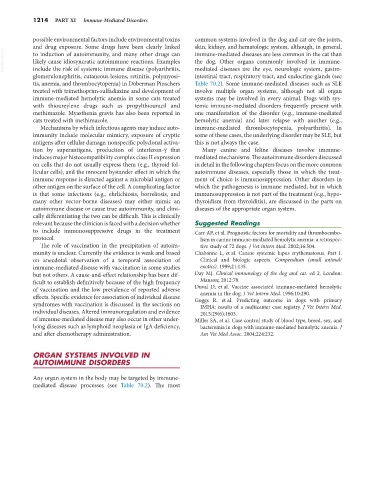Page 1242 - Small Animal Internal Medicine, 6th Edition
P. 1242
1214 PART XI Immune-Mediated Disorders
possible environmental factors include environmental toxins common systems involved in the dog and cat are the joints,
and drug exposure. Some drugs have been clearly linked skin, kidney, and hematologic system, although, in general,
VetBooks.ir to induction of autoimmunity, and many other drugs can immune-mediated diseases are less common in the cat than
the dog. Other organs commonly involved in immune-
likely cause idiosyncratic autoimmune reactions. Examples
include the risk of systemic immune disease (polyarthritis,
intestinal tract, respiratory tract, and endocrine glands (see
glomerulonephritis, cutaneous lesions, retinitis, polymyosi- mediated diseases are the eye, neurologic system, gastro-
tis, anemia, and thrombocytopenia) in Doberman Pinschers Table 70.2). Some immune-mediated diseases such as SLE
treated with trimethoprim-sulfadiazine and development of involve multiple organ systems, although not all organ
immune-mediated hemolytic anemia in some cats treated systems may be involved in every animal. Dogs with sys-
with thioureylene drugs such as propylthiouracil and temic immune-mediated disorders frequently present with
methimazole. Myasthenia gravis has also been reported in one manifestation of the disorder (e.g., immune-mediated
cats treated with methimazole. hemolytic anemia) and later relapse with another (e.g.,
Mechanisms by which infectious agents may induce auto- immune-mediated thrombocytopenia, polyarthritis). In
immunity include molecular mimicry, exposure of cryptic some of these cases, the underlying disorder may be SLE, but
antigens after cellular damage, nonspecific polyclonal activa- this is not always the case.
tion by superantigens, production of interferon-γ that Many canine and feline diseases involve immune-
induces major histocompatibility complex class II expression mediated mechanisms. The autoimmune disorders discussed
on cells that do not usually express them (e.g., thyroid fol- in detail in the following chapters focus on the more common
licular cells), and the innocent bystander effect in which the autoimmune diseases, especially those in which the treat-
immune response is directed against a microbial antigen or ment of choice is immunosuppression. Other disorders in
other antigen on the surface of the cell. A complicating factor which the pathogenesis is immune mediated, but in which
is that some infections (e.g., ehrlichiosis, borreliosis, and immunosuppression is not part of the treatment (e.g., hypo-
many other vector-borne diseases) may either mimic an thyroidism from thyroiditis), are discussed in the parts on
autoimmune disease or cause true autoimmunity, and clini- diseases of the appropriate organ system.
cally differentiating the two can be difficult. This is clinically
relevant because the clinician is faced with a decision whether Suggested Readings
to include immunosuppressive drugs in the treatment Carr AP, et al. Prognostic factors for mortality and thromboembo-
protocol. lism in canine immune-mediated hemolytic anemia: a retrospec-
The role of vaccination in the precipitation of autoim- tive study of 72 dogs. J Vet Intern Med. 2002;16:504.
munity is unclear. Currently the evidence is weak and based Chabanne L, et al. Canine systemic lupus erythematosus. Part I.
on anecdotal observation of a temporal association of Clinical and biologic aspects. Compendium (small animal/
immune-mediated disease with vaccination in some studies exotics). 1999;21:135.
but not others. A cause-and-effect relationship has been dif- Day MJ. Clinical immunology of the dog and cat. ed 2. London:
ficult to establish definitively because of the high frequency Manson; 2012:78.
of vaccination and the low prevalence of reported adverse Duval D, et al. Vaccine associated immune-mediated hemolytic
anemia in the dog. J Vet Intern Med. 1996;10:290.
effects. Specific evidence for association of individual disease Goggs R, et al. Predicting outcome in dogs with primary
syndromes with vaccination is discussed in the sections on IMHA: results of a multicenter case registry. J Vet Intern Med.
individual diseases. Altered immunoregulation and evidence 2015;29(6):1603.
of immune-mediated disease may also occur in other under- Miller SA, et al. Case control study of blood type, breed, sex, and
lying diseases such as lymphoid neoplasia or IgA deficiency, bacteremia in dogs with immune-mediated hemolytic anemia. J
and after chemotherapy administration. Am Vet Med Assoc. 2004;224:232.
ORGAN SYSTEMS INVOLVED IN
AUTOIMMUNE DISORDERS
Any organ system in the body may be targeted by immune-
mediated disease processes (see Table 70.2). The most

